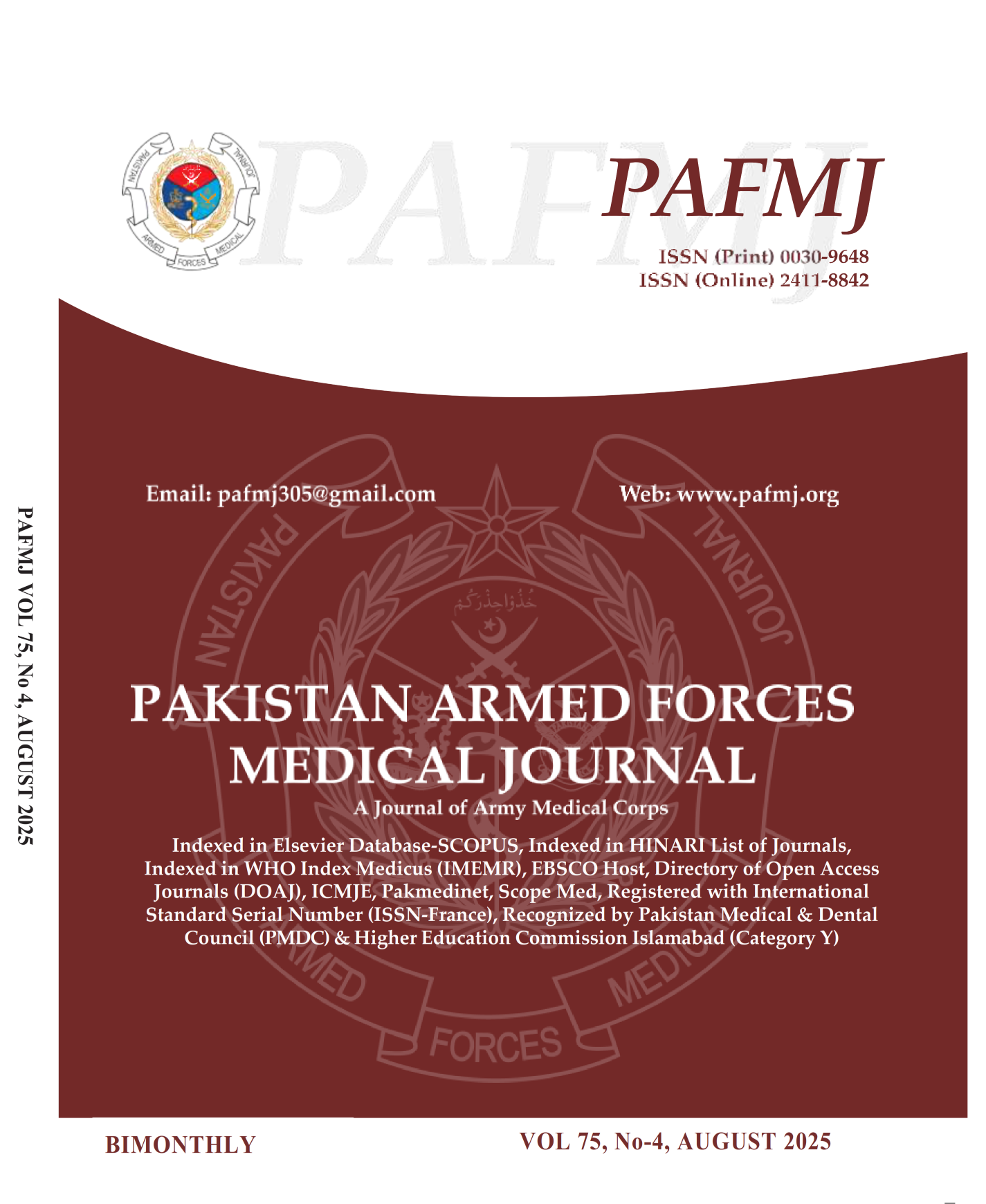Evaluating the Association of Hyperuricemia in End-Stage Renal Disease Patients on Hemodialysis at a Tertiary Care Hospital
DOI:
https://doi.org/10.51253/pafmj.v75i4.9450Keywords:
Chronic Kidney Disease, Glomerular Filtration Rate, Hemodialysis, Hyperuricemia, Peritoneal Dialysis, Renal Replacement Therapy, Uric Acid.Abstract
Objective: To highlight the association of hyperuricemia in patients of Chronic Kidney Disease stage 5 on Hemodialysis (CKD-5D) at a tertiary care hospital.
Study Design: Cross-sectional study.
Place and Duration of Study: Department of Nephrology and Dialysis Unit, Pak Emirates Military Hospital, Rawalpindi Pakistan, from Jul to Dec 2021.
Methodology: Using a consecutive sampling technique, CKD patients of either gender with age >15 years, both dialysis dependent (CKD-5D) and non-dialysis dependent (CKD-5ND), were included and divided into two groups of 80 each. Serum uric acid levels of both groups (CKD-5ND and CKD-5D) patients were assessed and analyzed. Measures of association odds ratio and the prevalence ratio, were calculated.
Results: The mean age was 53.76±18.26 years in Group-A (CKD-5ND) and 52.46±17.50 years in Group-B (CKD-5D) (p=0.667). Out of the total 80 CKD-5D patients in Group-B, 14(17.5%) underwent HD once weekly, 37(46.3%) twice weekly, and 29(36.3%) undergoing hemodialysis thrice weekly. CKD-5ND patients tend to have higher levels of uric acid as compared to CKD-5D patients, 51(63.8%) vs 33(41.3%), respectively (p=0.004). Patients undergoing once weekly hemodialysis had higher levels of uric acid, 9(27.3%), and patients undergoing twice or thrice weekly hemodialysis, 17(51.5%) and 7(21.2%), had hyperuricemia, respectively (p=0.032).
Conclusion. There is a high prevalence of hyperuricemia in CKD patients, and with declining eGFR, uric acid levels increase. Patients undergoing thrice weekly maintenance hemodialysis had a lower prevalence of raised uric acid levels with once weekly hemodialysis and CKD patients without hemodialysis.
Downloads
References
1. Lv JC, Zhang LX. Prevalence and Disease Burden of Chronic Kidney Disease. Adv Exp Med Biol 2019; 1165: 3-15.
https://doi:10.1007/978-981-13-8871-2_1
2. Shrestha N, Gautam S, Mishra SR, Virani SS, Dhungana RR. Burden of chronic kidney disease in the general population and high-risk groups in South Asia: A systematic review and meta-analysis. PLoS One 2021; 16(10): e0258494.
https://doi:10.1371/journal.pone.0258494
3. Gherghina ME, Peride I, Tiglis M, Neagu TP, Niculae A, Checherita IA. Uric Acid and Oxidative Stress-Relationship with Cardiovascular, Metabolic, and Renal Impairment. Int J Mol Sci 2022; 23(6): 3188. https://doi:10.3390/ijms23063188
4. Park JH, Jo YI, Lee JH. Renal effects of uric acid: hyperuricemia and hypouricemia. Korean J Intern Med 2020; 35(6): 1291-1304.
https://doi:10.3904/kjim.2020.410
5. Domínguez-Zambrano E, Pedraza-Chaverri J, López-Santos AL, Medina-Campos ON, Cruz-Rivera C, Bueno-Hernández F, et al. Association between Serum Uric Acid Levels, Nutritional and Antioxidant Status in Patients on Hemodialysis. Nutrients 2020; 12(9): 2600. https://doi:10.3390/nu12092600
6. Zawada AM, Carrero JJ, Wolf M, Feuersenger A, Stuard S, Gauly A, et al. Serum Uric Acid and Mortality Risk Among Hemodialysis Patients. Kidney Int Rep 2020; 5(8): 1196-1206.
https://doi:10.1016/j.ekir.2020.05.021
7. Oh TR, Choi HS, Kim CS, Bae EH, Ma SK, Sung SA, et al. Hyperuricemia has increased the risk of progression of chronic kidney disease: propensity score matching analysis from the KNOW-CKD study. Sci Rep 2019; 9(1): 6681.
https://doi:10.1038/s41598-019-43241-3
8. Sofue T, Nakagawa N, Kanda E, Nagasu H, Matsushita K, Nangaku M, et al. Prevalences of hyperuricemia and electrolyte abnormalities in patients with chronic kidney disease in Japan: A nationwide, cross-sectional cohort study using data from the Japan Chronic Kidney Disease Database (J-CKD-DB). PLoS One 2020; 15(10): e0240402. https://doi:10.1371/journal.pone.0240402
9. Bonino B, Leoncini G, Russo E, Pontremoli R, Viazzi F. Uric acid in CKD: has the jury come to the verdict? J Nephrol 2020; 33(4): 715-724.
https://doi:10.1007/s40620-020-00702-7
10. Khodabandeh N, Taziki E, Alirezaei T. Serum uric acid as a predictor of cardio- and cerebro-vascular diseases in maintenance hemodialysis patients. Rom J Intern Med 2022; 60(2): 115-122.
https://doi:10.2478/rjim-2021-0039
11. Bhattarai AM, Gurung S, Adhikari A, Karki S, Pathak BD, Regmi B, et al. Prevalence and clinical characteristics of hyperuricemia among patients with chronic kidney disease under haemodialysis in a tertiary care center: a cross-sectional study. Ann Med Surg 2024; 86(3): 1329-1334.
https://doi:10.1097/MS9.0000000000001731
12. Doualla M, Nkeck JR, Halle MP, Kamdem F, Agouak AI, Essouma M, et al. Assessment of the efficacy of hemodialysis on uric acid clearance in a sub-Saharan African population at the end stage kidney disease. BMC Nephrol 2020; 21(1): 378.
https://doi:10.1186/s12882-020-02037-8
13. Qayyum M, Butt B, Khan G. Hyperuricemia in pre-dialysis chronic kidney disease patients. A single centre experience. Pak Armed Forces Med J 2019; 69(1): 66-70.
https://www.pafmj.org/PAFMJ/article/view/2498
14. Moon F, Alam S, Yaqoob MY, Tofique M. Prevalence of Hyperuricemia in Thrice Weekly Hemodialysis Patients. Pak J Kidney Dis 2022; 6(3): 10.
https://doi.org/10.53778/pjkd6320514
15. Qidwai W, Jawaid M. Frequency of Uric Acid Levels, Symptomatic and Asymptomatic Hyperuricemia among the Pakistani Population. World Fam Med JournalMiddle East J Fam Med 2017; 15(7): 52–56.
http://dx.doi.org/10.5742/MEWFM.2017.93016
16. Kuo CF, Luo SF, See LC, Ko YS, Chen YM, Hwang JS, et al. Hyperuricaemia and accelerated reduction in renal function. Scand J Rheumatol 2011; 40(2): 116-121.
https://doi:10.3109/03009742.2010.507218
17. Rohn B, Jansing W, Seibert FS, Pfab T, Cinkilic O, Paßfall J, et al. Association of hyperuricemia and serum uric acid lowering therapy with mortality in hemodialysis patients. Ren Fail 2020; 42(1): 1067-1075.
https://doi:10.1080/0886022X.2020.1835674
18. Zhang J, Lu X, Li H, Wang S. Serum Uric Acid and Mortality in Patients with Chronic Kidney Disease: A Systematic Review and Meta-Analysis. Blood Purif 2021; 50(6): 758-766.
https://doi:10.1159/000513944
19. Muhammad TA, Muhammad RA, Khuram B, Muhammad NH. Hyperuricemia in Renal patients: Treat or not to treat. Arch Clin Nephrol 2021; 050–056.
https://dx.doi.org/10.17352/acn.000056
20. Petreski T, Ekart R, Hojs R, Bevc S. Hyperuricemia, the heart, and the kidneys - to treat or not to treat? Ren Fail 2020; 42(1): 978-986.
https://doi:10.1080/0886022X.2020.1822185
Downloads
Published
Issue
Section
License
Copyright (c) 2025 Muhammad Ansar, Khalid Mehmood Raja, Hafiz Asad Saeed, Muhammad Hammad, Falak Naz Alvi, Zain ul Abidin

This work is licensed under a Creative Commons Attribution-NonCommercial 4.0 International License.















